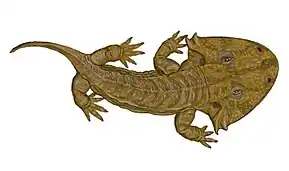Acanthostomatops
Acanthostomatops vorax
Acanthostomatops

Vue d'artiste d'Acanthostomatops vorax par Dimitri Bogdanov.
| Règne | Animalia |
|---|---|
| Embranchement | Chordata |
| Sous-embr. | Vertebrata |
| Classe | Amphibia |
| Ordre | † Temnospondyli |
| Sous-ordre | † Euskelia |
| Super-famille | † Eryopoidea |
| Famille | † Zatrachydidae |
- Acanthostoma vorax Credner, 1883
Acanthostomatops est un genre éteint d'amphibiens temnospondyles du Permien inférieur, découvert à Döhlen dans le bassin de la Saxe en Allemagne[2]. Ce genre n'est représenté que par une seule espèce, Acanthostomatops vorax[1].
Systématique
L'espèce Acanthostomatops vorax a été initialement décrite en 1883 par Hermann Credner (d) sous le protonyme d’Acanthostoma vorax[3]. Ce n'est qu'en 1961 qu’Oskar Kuhn l'a déplacée sous le genre Acanthostomatops créé spécialement pour elle.
Publication originale
- Espèce Acanthostomatops vorax sous le taxon Acanthostoma vorax :
- (de) Hermann Credner, « Die Stegocephalen aus dem Rothliegenden des Plauen'schen Grundes bei Dresden », Zeitschrift der Deutschen Geologischen Gesellschaft, Berlin, Deutsche Geologische Gesellschaft – Geologische Vereinigung (d), vol. 35, , p. 275-300 (ISSN 0012-0189 et 2700-3035, OCLC 62675553, lire en ligne)
Liens externes
- Genre Acanthostomatops :
- (en) Référence Paleobiology Database : Acanthostomatops Kuhn, 1961 † (consulté le )
- Espèce Acanthostomatops vorax
- (en) Référence Paleobiology Database : Acanthostomatops vorax (Credner, 1883) † (consulté le )
Notes et références
- Fossilworks Paleobiology Database, consulté le 25 mai 2021
- (en) Florian Witzmann et Rainer R. Schoch, « Skeletal development of the temnospondyl Acanthostomatops vorax from the Lower Permian Döhlen Basin of Saxony », Earth and Environmental Science Transactions of The Royal Society of Edinburgh, vol. 96, no 4, , p. 365–385 (ISSN 1473-7116 et 0263-5933, DOI 10.1017/S0263593300001358, lire en ligne, consulté le )
- Credner 1883, p. 277-289
- Portail de la paléontologie
- Portail de l’herpétologie
- Portail de la Saxe
Cet article est issu de Wikipedia. Le texte est sous licence Creative Commons - Attribution - Partage dans les Mêmes. Des conditions supplémentaires peuvent s'appliquer aux fichiers multimédias.